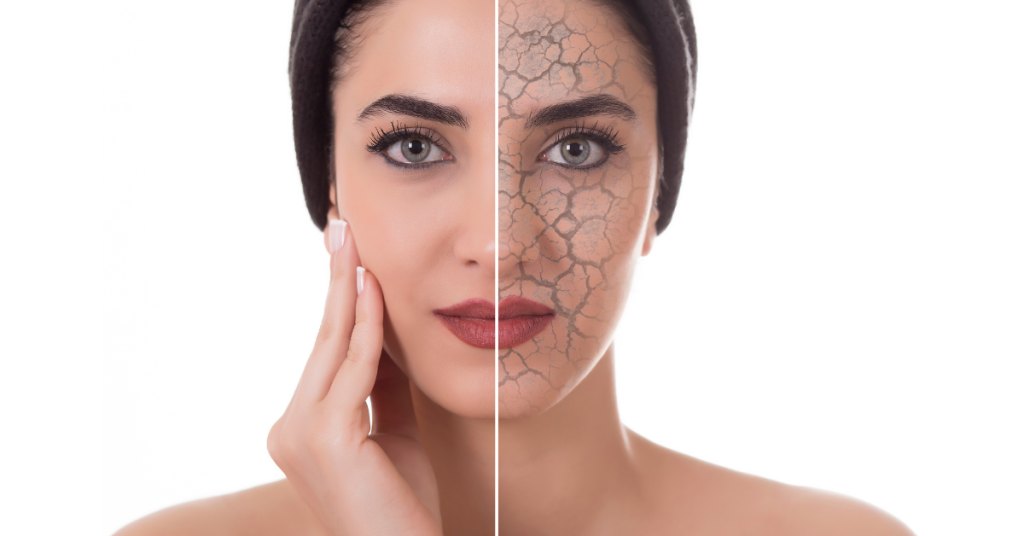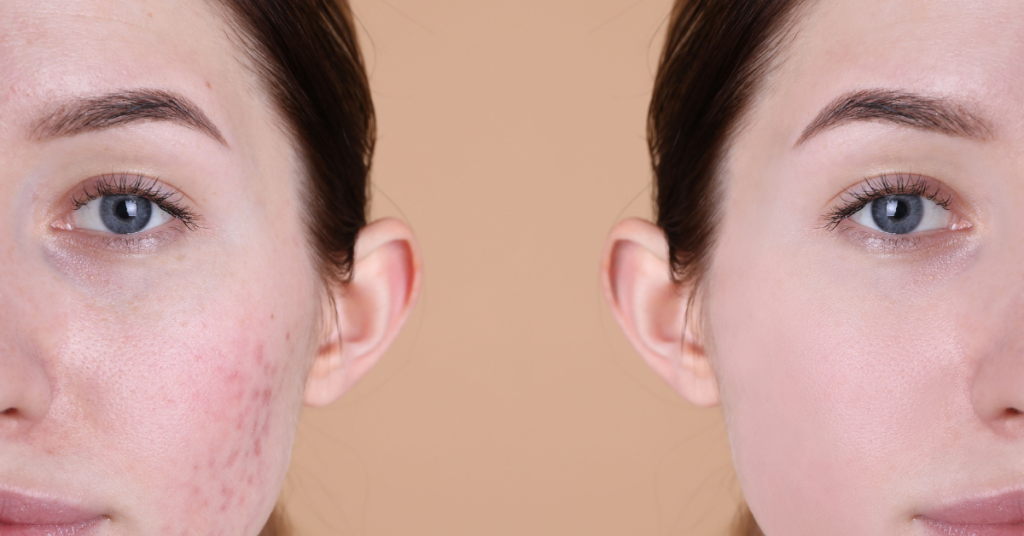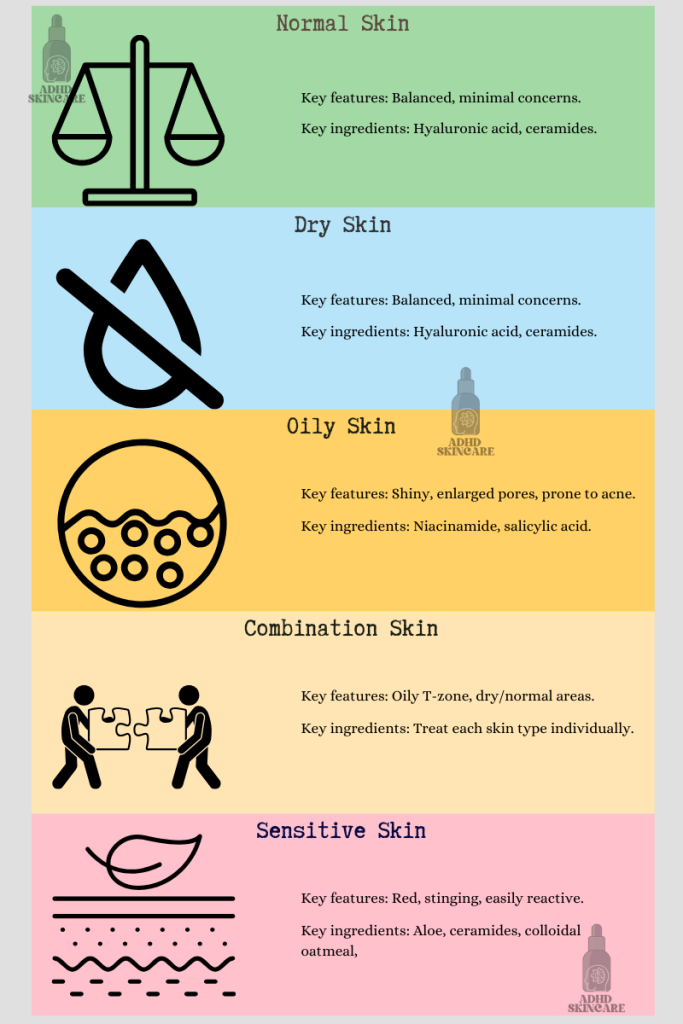
Here’s the deal: If you want a shot at great skin, step one is understanding your skin type. Using skincare products without being 100% sure about your skin type and figuring out its traits is exactly like self-medicating — imagine taking Advil for itchy eyes. Your skin is unique, shaped by genetics, climate, and a whole bunch of other quirks. But it still falls into one of the five major skin type classes. These are normal, dry, oily, combination, and sensitive skin types.
There are a whole bunch of reasons you absolutely need to understand your skin type. For one, it gives you a real-life shield against bad social media skincare advice and it’ll save you the heartbreak of using a product that ruins your skin.
You’ve probably heard this advice a million times, but it’s absolutely relevant. Your skin type determines everything: how you should wash your face, which products to use, and which beauty procedures to choose. Think about it this way: When you read an article or take a quiz to figure out your skin type, you’re giving your skin an edge money can’t buy.
Plus, understanding your skin helps you save a ton on products you don’t need because you’ll already know what works for you. It’s a win-win! The only real downside to knowing your skin type is that you might get hooked on skincare and end up buying an at-home course to learn more.
If you have ADHD and don’t want to read an entire article about all the skin types, take our skin type test and come back here to read up on your results. We also have a TLDR version right at the end.
Skin Types are Divided into 5 Major Categories

The 5 skin categories are:
- Normal skin type
- Dry skin type
- Oily skin type
- Combination skin type
- Sensitive skin type
Take this quiz to figure out yours. We’ll redirect you back here to learn more.
Normal Skin: The Unicorn of Skin Types

Normal skin is the Beyoncé of skin types. It maintains a natural harmony, and everyone wishes they had it. If this is where you fall, you’ll probably learn the ropes quickly. This skin type is well-balanced and produces just the right amount of sebum. Sebum, by the way, is the natural oil your skin’s sebaceous glands produce to keep it moisturized and protected.
Since your skin’s natural oils are at equilibrium, you don’t have to worry about many of the skin conditions other types face. Your skin is neither too dry nor too oily, which means you enjoy good texture, small pores, few imperfections, and impressive elasticity. Your skin barrier is also healthy and remains resilient through seasonal changes. In short, you won the skin lottery.
But newsflash: It’s not all smooth sailing. While you may not face specific skin concerns, maintaining your well-balanced skin requires some effort. You’ll need to be intentional with your skincare products since many are targeted at specific concerns like dryness or oiliness. In other words, using the wrong skincare products could give you problems you didn’t have to begin with!
Tips to care for normal skin

So, how do you build a skincare routine for normal skin without ruining it? Here are some tried-and-true tips:
- Keep your routine simple:
One of the easiest ways to disrupt the balance of normal skin is by using too many products. Remember, less is more. Layering too many active ingredients on normal skin can irritate the skin or disrupt its natural barrier. Instead, invest in masks or dermatologist-recommended skincare tools for occasional use. - Use an ingredient checking app plus AI:
While a dermatologist is your best bet for creating a tailored routine, other tools like INCI Decoder can guide your choices in the meantime. Once you have a product in mind to try, follow our simple three-step process in deciding if a skincare product is good for you.
Dry Skin; It’s Travails and Triumphs

If you have dry skin, you’ve probably gotten the message loud and clear: your skin needs hydration — lots of it. But if you want healthy skin, you also need moisturization. Let’s break it down: Hydration refers to the water levels in your skin, which help keep it protected, elastic, and give it a smooth texture. Moisturization, on the other hand, is the process of sealing your skin’s hydration in.
The problem is dry skin doesn’t produce enough sebum, which is the natural oil produced by your skin’s sebaceous glands. Since sebum is largely responsible for moisturization (locking hydration in), dry skin has a reduced ability to retain water. This is why your skin easily feels tight. Sebum also forms part of the skin’s natural lipid layer, which is a super important part of your skin’s barrier that multitasks.
The lipid layer shields the skin from harmful external factors, helps it heal from damage, protects its texture, and helps it retain water. As a result, many people with dry skin also experience sensitivity due to a compromised skin barrier.
So, how do you keep your skin moisturized and safe? The answer is a healthy, hydration-focused routine. The best way to care for dry skin is by blending hydration and oil-based moisturization while avoiding harsh cleansers or products that strip your natural oils — because, let’s face it, you need every drop of those oils!
Tips to care for dry skin

- Hydrate and moisturize your skin:
Remember that dry skin desperately needs hydration and moisturization. And as a bonus tip; drink more water and use warm water for baths because hot water can dry out your skin. - Care for your skin right after your bath:
Don’t wait till your skin feels tight to care for it. Use your skincare products immediately — and yes, with damp skin. - Avoid harsh skincare products:
Using harsh products is one of the easiest ways to destroy your skin barrier. Choose a gentle cleanser and avoid ingredients like alcohol, sulfates, fragrances, or harsh actives that dry out your skin. As a rule, don’t use products that take moisture or oils from your skin without putting it right back. Instead, use hydrating cleansers and other moisture-focused products. - Use an ingredient checking app plus AI:
While a dermatologist is your best bet for creating a tailored routine, other tools like INCI Decoder can guide your choices in the meantime. Once you have a product in mind to try, follow our simple three-step process in deciding if a skincare product is good for you. - Sun protection is key:
Without sunscreen, hydration and moisturization are exposed to the sun which can be really drying. To prevent this, use a broad spectrum product with at least SPF 30. IT gives your skin a better shot at locking moisture in. Plus, it’s really good for your skin texture, too!
Now that you’ve got the basics, you’re ready do dive into a simple step-by-step skincare routine for dry skin. P.S. It’s ADHD friendly, which is great for anyone looking for simplicity!
Relax, It’s Just Oily Skin (And Here’s How to Handle It)

Oily skin is one of the most imposing skin types; it doesn’t wait for you to figure it out. If you have this skin type, you have definitely noticed how greasy certain areas of your skin get. You probably already know to avoid certain beauty products because they make you excessively oily, which leads to acne breakouts. This happens because your sebaceous glands, which produce sebum, work overtime.
They are like hard workers that mean well, but never take a break and end up doing too much. Sebum, by the way, is the natural oil your skin’s sebaceous glands produce to keep it moisturized and protected. Some hallmarks of this skin type include a shiny appearance that never seems to go away, enlarged pores, and frequent bouts of acne. To be fair, these downsides might sound rough, but there are some pros to oily skin type.
For one, you’ll fare better in winter than everyone else, because your sebaceous glands help protect against the chill and dryness. Another advantage is that oily skin tends to age more slowly, as the natural oils help maintain skin elasticity and reduce fine lines. Additionally, most of the work required to take care of this skin type is in understanding your skin. This includes knowing your triggers, choosing appropriate products, and managing oil production.
Tips to care for oily skin

Here are some of the top tips to help you care for oily skin, acne-prone skin.
- Non-comedogenic products are essential:
Non-comedogenic refers to products that are specially formulated without ingredients that can clog your pores. Remember, excess sebum and clogged pores are a recipe for breakouts, blackheads, and acne. - Oil-free products are your go-to:
Moisturization and hydration don’t have to involve oils. If you have oily skin, go for an oil-free moisturizer. It will lock in your skin’s hydration using emollients, humectants, and non-oily occlusives. These do not contain oils and are safe for your skin. - Don’t forget sunscreen:
Oily skin needs sunscreen too! You might think exposing your skin to the sun’s drying effects could help, but the sun bakes unprotected oily skin. This could open the door to a whole new world of problems. Use a broad spectrum product with at least SPF 30. Don’t forget to reapply after every two hours. - A winning strategy:
The best way to handle oily skin is to go for products that gently reduce oil production without any side effects. Ingredients like denatured alcohol are often used in skincare products because they are intensely drying and strip moisture away. However, oily skin has resilient sebaceous glands and attempting to dry them out with harsh products, only makes them work harder. The key is to regulate oil production without over-drying the skin by using gentle oil-regulating products like niacinamide. - Use an ingredient checking app and AI tools:
While a dermatologist is your best bet for creating a tailored routine, other tools like INCI Decoder can guide your choices in the meantime. Once you have a product in mind to try, follow our simple three-step process in deciding if a skincare product is good for you.
Combination Skin; Understanding The Great Confusion

Amusingly, one of the most common traits of combination skin is its confusing nature. How can your skin be both dry (or normal) and oily? The good news is that this skin type is pretty manageable once you get the hang of it. But before we get into it, here’s what you need to know:
- Normal skin: Produces just the right amount of sebum.
- Dry skin: Produces less sebum than you need.
- Oily skin: Produces too much sebum.
To clarify: Sebum is the natural oil your skin’s sebaceous glands produce to help it seal helpful hydration in. Hydration keeps your skin healthy, smooth, protected, and generally in top-form. Unlike combination skin, other skin types produce a uniform amount of sebum, but different parts of combination skin produce varying amounts of sebum. So, how do you manage it?
The first step is figuring out what parts of your skin are dry (or normal) and what parts are oily. For most people, their T-zone (the forehead, nose, and chin) is one skin type, and the rest of their face is another skin type. Oily T-zones are really common because this area has a higher concentration of sebaceous glands than other areas of the face. If your skin appears shiny at your T-Zone, Bingo!
Unfortunately, managing combination skin isn’t straightforward. You’ll need one type of treatment for your forehead, nose, and chin, and another for the rest of your face. People with combination skin can have dry patches or occasional breakouts if they don’t don’t tailor their skincare routine to meet the different needs of their skin.
The toughest part about managing combination skin is balancing two different skin needs, but it is possible and you can do it and have healthy skin!
Tips to care for combination skin

Here are a couple of tips to help you meet your combination skin’s needs.
- Identify your skin zones:
This is important to be able to control oily skin while relieving dry skin or maintaining normal skin. - Treat each part individually:
Since combination skin features two different skin types, you need to treat it as such. This requires learning about both dry (or normal) and oily skin care. After you do this, you have two options. The first is using products with ingredients that can cater to both of the skin types you have. And the second is using oily skin products for your T-zone and dry (or normal) skin products for the parts that need it. The same applies to serums and masks. However, it’s worth noting that using a product that can cater to both skin types is only easy if you have oily and normal skin types. With oily and dry skin types, it is a lot more difficult. - Use the right sunscreen:
Irrespective of your skin’s features, sunscreen is a necessity because it protects all skin types. Invest in a broad spectrum brand with at least SPF-30. Choose a product that is oil-free and non-comedogenic, so it works for both your oily and dry (or normal) areas. - Choose simple products:
Use lightweight, balanced products where possible to simplify your routine. Don’t forget to avoid overly harsh products that could exacerbate dryness or oiliness. - Use an ingredient checking app and AI tools:
While a dermatologist is your best bet for creating a tailored routine, other tools like INCI Decoder can guide your choices in the meantime. Once you have a product in mind to try, follow our simple three-step process in deciding if a skincare product is good for you.
Sensitive Skin: The Art of Negotiating With Your Skin

Sensitive skin is the most responsive of all skin types thanks to its easily-compromised barrier . It makes itself known and demands to be catered to. Think about it as the most dramatic of the five. Sensitive skin demands attention and extra care due to its reactivity. Falling into this category means that you react to a variety of triggers, including environmental factors, certain skincare ingredients, harsh products, lifestyle habits, and internal conditions.
This skin type is prone to irritation and redness and cannot stand a number of the ingredients and procedures that other skin types can. It can tag along dry, oily, normal, or combination skin. This means taking care of sensitive skin involves understanding your its needs and sensitivity.
If this sounds dreadful or scary, don’t fret. There are a couple of tried and trusted methods to keep your skin healthy and avoid triggers. The hardest part is finding products that don’t irritate your skin’s protective barrier and there are a few tricks to better your odds.
Tips to care for sensitive skin
Here are a couple of tips to help keep your sensitive skin healthy.

- Stick to hypoallergenic and fragrance-free products:
Some of the most common sensitive skin triggers are products that are not hypoallergenic and contain fragrance. Hypoallergenic products are formulated specially to reduce well-known irritants and fragrance-free products don’t contain any synthetic or natural fragrances which often cause irritation. This means sticking to a fragrance-free cleanser and hypoallergenic products for your entire routine. - Patch test:
Patch testing is the savior of sensitive skin. Before you use any skincare products on your face or body, use it on a small part of your arm and study it for at least a day. Your face is the most sensitive part of your body. Don’t use products on it without patch-testing. - Harsh products are a no-no:
Stick to mild products to avoid irritation. Go for a gentle cleanser and avoid harsh actives. Your skin health depends on it. - Approach new beauty procedures with caution:
Unfortunately, even some beauty procedures can irritate your skin. Steaming, for example, may cause flare up in sensitive skin. It’s important to really research any procedure before you use it to avoid skin irritation. The same goes for any product you use on your skin. - Use an ingredient checking app and AI tools to weed out potential irritants:
While a dermatologist is your best bet for creating a tailored routine that won’t cause skin irritation, other tools like INCI Decoder can guide your choices in the meantime. Once you have a product in mind to try, follow our simple three-step process in deciding if a skincare product is likely to cause irritation. - Sunscreen:
Sunscreen is one of the best ways to protect your skin barrier. Don’t forget to use a broad-spectrum brand with at least SPF 30. - Know the calming ingredients:
So what happens if your skin gets irritated? Is there something you can do? The answer is yes. There are a couple of ingredients famed for their calming abilities. Some of these are aloe vera, colloidal oatmeal, ceramides, green tea, and hyaluronic acid.
ADHD Skin Type Summary

Since ADHD affects your skincare routine in multiple ways, we’ve designed the perfect TLDR (too long, didn’t read) version. It’s perfect for anyone short on time!
TLDR Skin Types, Traits, Care, and Essentials (ADHD Version)
| Skin Type | Key Traits | Main Care Tips | Essential Products |
| Normal skin | Balanced, small pores, few imperfections | Simple routine, use SPF | Gentle cleanser, SPF 30+ |
| Dry skin | Lacks sebum, prone to dehydration | Hydrate & moisturize, avoid harsh cleansers | Dry skin needs hydrating cleanser, rich moisturizer |
| Oily skin | Excess natural sebum, shiny, prone to acne | Use non-comedogenic, oil-free products, SPF | Oil-free moisturizer, SPF 30+ |
| Combination skin | Oily T-zone (forehead, nose, and chin), dry/normal elsewhere | Treat zones separately, use simple products | Lightweight, non-comedogenic sunscreen |
| Sensitive skin | Easily irritated, reactive | Use hypoallergenic, fragrance-free products | Gentle cleanser, calming ingredients (aloe, ceramides) |
TLDR Skin Types and Tips to Retain Healthy Skin (ADHD Version)
| Skin Type | Tips to Retain Healthy Skin |
| Normal skin | Keep normal skin routine simple. Always use broad-spectrum sunscreen. Avoid overusing products. |
| Dry skin | Hydrate skin and body. Use a rich moisturizer. Avoid hot water; it worsens dry skin Apply products on damp skin. Avoid harsh cleansers on dry skin. Broad-spectrum sunscreen is a necessity. |
| Oily skin | Use non-comedogenic and oil-free products. Simplify your routine. Pick products that reduce oil production. Check ingredients for oil-absorbing properties. Always wear broad-spectrum sunscreen. |
| Combination skin | Identify oily and dry areas. Treat each area individually. Read about both dry (or normal) and oily skin care. Always wear broad-spectrum sunscreen. |
| Sensitive skin | Stick to hypoallergenic, fragrance-free products. Patch test every product. Use mild products and gentle cleansers. Research beauty procedures carefully. Broad-spectrum sunscreen is essential. Know calming ingredients. |
So, what’s next?
Now that you know the basics about your skin type, it’s time to go a bit deeper and find out how to create the perfect skincare routine for your skin type. Be sure to check out the secret ingredient to great skin for ADHD.
